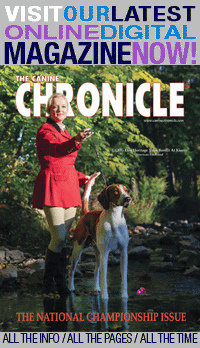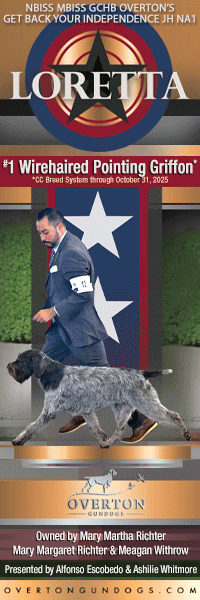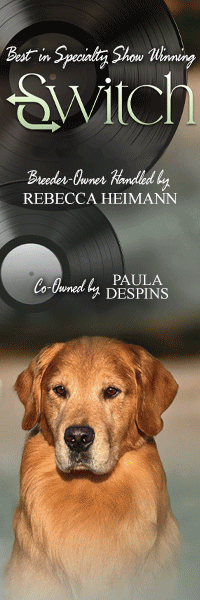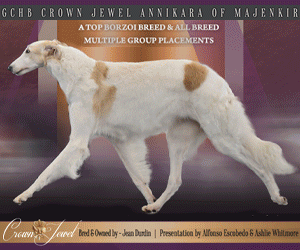Ch. Vigow of Romanoff – The History-Making Borzoi

Vigow was undefeated in breed competition, ultimately winning 63 groups and 21 BIS
By Amy Fernandez
On March 11, 1936 AKC crowned its first American-Bred dog of the year. Ironically, the honor went to a Borzoi, then known as the Russian Wolfhound, breeder/owner/handled by the French-born Louis Murr. His Romanoff Borzoi kennel in Spring Valley, New York produced decades of winners. But none equaled the fame of Ch. Vigow of Romanoff.
Offered annually until 1939, AKC’s American-Bred competition was initiated to showcase and encourage American breeders at a time when imports dominated the ring. Finalists were selected on the basis of group wins and Vigow defeated some heavy hitters that year including Mrs. Cheever Porter’s Irish Setter, Ch. Milson O’Boy, Marie Leary’s Ch. Anthony of Cosalta, and one of the Bondy’s best Wires, Ch. Leading Lady of Wildoaks.
Vigow repeated this feat in 1937, and remained top-ranked until 1938, eclipsing the record of his equally famous sire Ch. Vigow O’Valley Farm. His career included 38 Group Firsts and eight BIS wins, accomplishments that seemed highly unlikely when Murr acquired him in 1929.
Then in deplorable condition, Murr purchased him solely for his dazzling pedigree, which melded perfectly with the breeding program he had been constructing since 1920. Bred to a third generation Romanoff bitch, Vigow justified Murr’s hunch. The litter yielded four champions including two BIS winners.
Murr’s Romanoff bloodline was founded on stock tracing directly to Borzoi imported by Joseph Thomas for his legendary Valley Farm kennel in nearby Connecticut. The undisputed superstar among them was Vigow’s grandsire, Ch. Bistri of Perchino, bred by Grand Duke Nikolai Nikolaievich and imported to America in 1903.
Despite growing popularity since the first Borzoi arrived from England in 1899, quality and type were conspicuously scarce, nothing like the powerful, graceful coursing hounds Thomas envisioned. He knew what he wanted. Finding it was another story. After visiting kennels in America, Canada, and Europe he was equally disappointed by Russian Borzoi until he ventured thousands of miles to a kennel in the remote province of Tula. There he found over 300 Borzoi personifying the type he imagined with long beautiful heads, great bone and muscle, deep chests, excellent feet, and gorgeous coats.
They represented three decades of dedication for Grand Duke Nicholas, uncle of Russia’s last Czar. Once common, Russia’s grand hunt kennels disappeared in the wake of economic and social upheavals. Perchino was an anachronism, but creating it had required more than royal money and connections. For decades, Russian Borzoi were heavily crossbred to Greyhounds. Purebred specimens became extremely rare.
Thomas returned with stock from two remaining strongholds of working type, Perchino and Woronzova, including Bistri and Raskida, sire and dam of his superstar Ch. Rasboi O’Valley Farm, BOB at Westminster four consecutive years. Within a year, Valley Farm Borzoi annihilated the competition. In little over a decade, Thomas achieved his ambition of reinstating genuine Borzoi type. His well-timed imports also ensured the perpetuation of crucial bloodlines after Imperial Russia’s demise. He was instrumental in founding the Russian Wolfhound Club of America and authored the breed’s first American standard. His meteoric rise was matched by his abrupt departure from the breed. “The Valley Farm Kennels produced hundreds of high-class borzoi; indeed, twenty-five years ago it would have been difficult to find from one end of the country to the other an American-bred borzoi that wasn’t chock-full of Valley Farm blood – a stream of lineage that had its direct source at the fountainhead of all that was good in Russia.” (AKC Gazette, Oct. 1931) Valley Farm stock seeded key bloodlines including Romanoff.

AKC Judge Mr. Louis Murr
Murr’s involvement with Borzoi commenced in 1914 and he registered his Romanoff prefix in 1922. In 1931 he relocated his growing kennel to ten acres in Spring Valley. He converted a hillside barn into the main kennel, built dozens of spacious pens and paddocks, but preferred allowing his dogs maximum freedom. Vigow was a living testament to his belief in premium food and unlimited exercise. Romanoff maintained 40 adults and bred about 75 puppies annually. Rarely kenneled, they generally lived in large groups. Famed for their rock hard condition, Murr also believed that this unrestricted, natural environment encouraged steadiness and minimized fighting.
In 1938, the AKC Blue Book of Dogs called Romanoff Borzoi Kennel, “one of the largest on this continent, if not the largest; one of the best, if not the best.” Murr routinely piled six to eight Borzoi into his car for, undoubtedly lively, drives to shows. Shown 72 times, Vigow was undefeated in breed competition, ultimately winning 63 groups and 21 BIS. This total might have gone higher. Unfortunately his career abruptly ended at age five when he was killed by a kennelmate.

Judge Mr. Louis Murr WKC 1969 BIS award to Ch. Glamoor Good News, owner/handled by Walter Goodman
Murr went on to produce other notable winners, taking two of them to Westminster group wins in 1942 and 1943. He is best remembered as a popular all breed judge. He judged 19 Westminster assignments between 1925 and 1971 including his 1969 BIS award to Ch. Glamoor Good News, owner/handled by Walter Goodman. Numerous important American bloodlines like Tamboer and Majenkir have been founded on Romanoff stock.
Short URL: http://caninechronicle.com/?p=27980
Comments are closed











